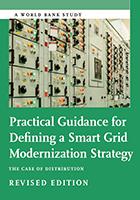Publications
There is no one definition of the smart grid concept. Instead, smart grids are defined differently around the world to reflect local requirements and goals. What is clear, however, is that the grids of today will not support the energy goals of the future. The integration of large shares of renewable energy, improvements in the reliability of services, and the achievement of higher levels of energy efficiency across the value chain will require power grids that are largely different from those of today. This book guides stakeholders on how utilities can define their own smart grid vision, identify priorities, and structure investment plans. While most of these strategic aspects apply to any area of the electricity grid, the book focuses on distribution. The guidance includes key building blocks for modernizing the distribution grid and provides examples of grid modernization projects.
This revised edition also includes key communication system requirements to support a well-functioning grid. The concept of the smart grid is relevant to all grids. What varies are the magnitude and type of the incremental steps toward modernization for achieving a specific smart grid vision. A utility that is at a relatively low level of grid modernization may leapfrog one or more levels of modernization to achieve some of the benefits of the highest levels of grid modernization. Smart grids impact electric distribution systems significantly. In developing countries, modernizing the distribution grid promises to benefit the operation of electric distribution utilities in many and various ways.
These benefits include improved operational efficiency (such as reduced losses and lower energy consumption), reduced peak demand, improved service reliability, and ability to accommodate distributed generating resources without adversely impacting overall power quality. Practical Guidance for Defining a Smart Grid Modernization Strategy concludes by describing funding and regulatory issues that may need to be taken into account when developing smart grid plans. The World Bank Studies series is available for free download online through the Open Knowledge Repository https://openknowledge.worldbank.org).
Madrigal, Marcelino; Uluski, Robert; Gaba, Kwawu Mensan. 2017. Practical Guidance for Defining a Smart Grid Modernization Strategy. Washington, D.C.: World Bank Group. http://documents.worldbank.org/curated/en/208631489661030061/Practical-guidance-for-defining-a-smart-grid-modernization-strategy
